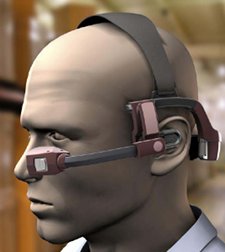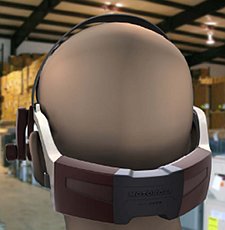Head-mounted computer offers voice recognition
May 11, 2009 — by LinuxDevices Staff — from the LinuxDevices Archive — 8 views Kopin is showing off a Motorola-branded computer built into a Bluetooth headset (left), providing a “virtual 15-inch display” via a swing-down eyepiece. The “Golden-i” incorporates speech recognition, weighs three ounces, and runs Linux or Windows CE for more than eight hours per charge, says the company.
Kopin is showing off a Motorola-branded computer built into a Bluetooth headset (left), providing a “virtual 15-inch display” via a swing-down eyepiece. The “Golden-i” incorporates speech recognition, weighs three ounces, and runs Linux or Windows CE for more than eight hours per charge, says the company.
(Click here for a larger view of the Kopin Golden-i)
 The BlueRadios WiPC (Click image for further information) |
Like the WiPC portable media player (right) announced by BlueRadios last week, the Golden-i incorporates Kopin's CyberDisplay, a “third-generation” micro-display that measures 0.6 inches diagonally, offers 800 x 600 pixel resolution, and is claimed to look like a 15-inch monitor when positioned close to the eye. But, while the WiPC is designed for “content snacking” and must be held up to the eye manually, the Golden-i is built into a Bluetooth headset.
According to Kopin, the Golden-i uses its Bluetooth 2.0 radio to make a wide area connection via a cellular phone or other host device, and is designed to provide a user with remote access to their office desktop computer. Kopin claims the headset, which runs Windows CE 6.0 R2, provides “full hands-free access to all PC applications, data files, and services,” via Nuance VoCon 3200 speech recognition software. Thanks to an integral, six-axis position tracker from Hillcrest Labs, it's said, users can operate a cursor with “nearly pixel-for-pixel accuracy,” and zoom in and out on their remote desktops.


Kopin's head-mounted computer (left) is depicted with Motorola branding (right)
(Click either image to enlarge)
As pictured above, Kopin released renderings of the Golden-i that carry Motorola branding, and also provided the press with documentation suggesting that the device might be brought to market by Motorola. (Despite the falling market share of Motorola's handset division and the parent company's financial losses, Moto's Enterprise Mobile Solutions group continues to be profitable.)
Apart from emphasizing the possibility of accessing enterprise computers via Microsoft's Remote Desktop Protocol (RDP), Kopin didn't say what software the Golden-i will come with. But the company says the headset will provide “hands-free spontaneous access to all digital information, broadcast programming and Internet services,” and is compatible with 480p (720 x 480 pixel) video at up to 30 frames per second. While WiFi is apparently not included on the initial prototypes, it will be added later for autonomous web browsing, the company says.
Kopin says the Golden-i's speech recognition provides “over 90 percent proficiency straight out of the box,” requires no push-to-talk button, and is always ready to react to a user's requests. In addition, the device is also said to incorporate text-to-speech capabilities, enabling it to read back documents, e-mails, web pages, or other text displayed on screen.
Like the WiPC mentioned earlier in this story, the Golden-i uses a Cortex-A8-based Texas Instruments OMAP3530 system-on-chip (SoC) clocked at 600MHz. The amount of memory included on the device is not specified, but the headset will include both a mini-USB port and a microSD expansion slot, Kopin says. The headset will operate for more than eight hours using a single 1200 mAh battery, the company adds.
Features and specifications listed for the WiPC include:
- Processor — TI OMAP3530 clocked at 600MHz
- Display — Kopin SVGA (800 x 600) liquid crystal micro display (LCD)
- Networking:
- Bluetooth 2.0
- WiFi — “Will be offered soon”
- Bluetooth 2.0
- User interface — Includes speech recognition and motion sensing
- Other I/O — 1 x USB
- Expansion — microSD slot
- Power — 1200 mAh battery provides more than eight hours of operation
- Weight — 3 oz (85g)
- Operating system — Linux, Windows CE
Kopin says it has shipped more than 30 million microdisplays, already commonly used in devices such as digital cameras, personal video eyewear, camcorders, thermal weapon sights and night vision systems. The company's proprietary displays and heterojunction bipolar transistors (HBTs) are said to be protected by more than 200 global patents and patents pending.
Availability
According to Kopin, Golden-i prototypes will soon be placed with “several industrial organizations” for several months of field testing and evaluation. Mass production is expected to begin in 2010, the company adds.
This article was originally published on LinuxDevices.com and has been donated to the open source community by QuinStreet Inc. Please visit LinuxToday.com for up-to-date news and articles about Linux and open source.